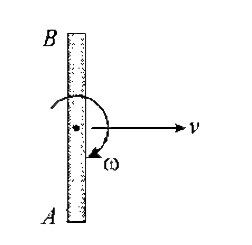An ice skater having moment of inertia l rotating with angular speed ω suddenly opens her arms, which reduces her angular velocity to ω4. Calculate the change in moment of inertia of the dancer.
To solve the problem, we will use the principle of conservation of angular momentum.
1. Understanding the Initial Conditions:
- The initial moment of inertia of the ice skater is denoted as I.
- The initial angular speed is ω.
2. Understanding the Final Conditions:
- After the skater opens her arms, her angular speed reduces to ω4.
- We need to find the new moment of inertia, which we will denote as I′.
3. Applying the Conservation of Angular Momentum:
- According to the conservation of angular momentum, the initial angular momentum must equal the final angular momentum:
I⋅ω=I′⋅(ω4)
4. Setting Up the Equation:
- Substitute the known values into the equation:
I⋅ω=I′⋅ω4
5. Canceling Out Angular Speed:
- Since ω is not zero, we can divide both sides of the equation by ω:
I=I′⋅14
6. Solving for the New Moment of Inertia:
- Rearranging the equation gives us:
I′=4I
7. Calculating the Change in Moment of Inertia:
- The change in moment of inertia (ΔI) is given by:
ΔI=I′−I=4I−I=3I
Final Results:
- The new moment of inertia I′ is 4I.
- The change in moment of inertia ΔI is 3I.
- The initial moment of inertia of the ice skater is denoted as I.
- The initial angular speed is ω.
- After the skater opens her arms, her angular speed reduces to ω4.
- We need to find the new moment of inertia, which we will denote as I′.
- According to the conservation of angular momentum, the initial angular momentum must equal the final angular momentum:
I⋅ω=I′⋅(ω4)
- Substitute the known values into the equation:
I⋅ω=I′⋅ω4
- Since ω is not zero, we can divide both sides of the equation by ω:
I=I′⋅14
- Rearranging the equation gives us:
I′=4I
- The change in moment of inertia (ΔI) is given by:
ΔI=I′−I=4I−I=3I
- The new moment of inertia I′ is 4I.
- The change in moment of inertia ΔI is 3I.
Topper's Solved these Questions
- SYSTEM OF PARTICLES AND ROTATIONAL MOTIONBOOK - AAKASH INSTITUTECHAPTER - SYSTEM OF PARTICLES AND ROTATIONAL MOTIONEXERCISE - Assignment (Section - J) Aakash Challengers Questions
13 Videos
- SEMICONDUCTOR ELECTRONICS: MATERIALS, DEVICES AND SIMPLE CIRCUITSBOOK - AAKASH INSTITUTECHAPTER - SEMICONDUCTOR ELECTRONICS: MATERIALS, DEVICES AND SIMPLE CIRCUITSEXERCISE - Assignment (Section-D (Assertion and reason))
5 Videos
- TEST 1BOOK - AAKASH INSTITUTECHAPTER - TEST 1EXERCISE - EXERCISE
9 Videos
Similar Questions
Does the moment of inertia of abody change with the speed of rotation ?
View SolutionA circular disc of moment of inertia It is rotating in a horizontal plane about its symmetry axis with a constant angular velocity ωi. Another disc of moment of inertia Ib is dropped co-axially onto the rotating disc. Initially, the second disc has zero angular speed. Eventually, both the discs rotate with a constant angular speed ωf. Calculate the energy lost by the initially rotating disc due to friction.
View Solution
Knowledge Check
A torque T acts on a body of moment of inertia l rotating with angular speed ω. It will be stopped just after time
AlTωBlωTCTωlDlωTIf the angular velocity of a rotating rigid body is increased then its moment of inertia about that axis
AincreasesBdecreasesCbecomes zeroDremains unchangedThe moment of inertia (I) and the angular momentum (L) are related by the expression
AI=LωBL=IωCL=I2ωDω=LI
The moment of inertia of a body moving with angular velocity ω decreases from l to l3 without any external torque. Calculate the new angular velocity of the body.
View SolutionA ballet dancer spins about a vertical axis at 60r± with arms outstretched. When her arms are folded the angular frequency increases to 90r±. Find the change in her moment of inertia.
View SolutionA hollow sphere partly filled with water has moment of inertia I when it is rotating about its own axis at an angular velocity ω. If its angular velocity is doubled then its moment of inertia becomes
View SolutionA flywheel of moment of inertia I is rotating with uniform angular speed ω. If a torque τ retards the wheel, then the time in which the wheel comes to rest is
View SolutionA uniform rod AB of length l rotating with an angular velocity ω while its centre moves with a linear velocity v=ωl6 If the end A of the rod is suddenly fixed, the angular velocity of

View Solution